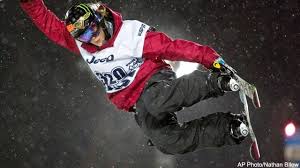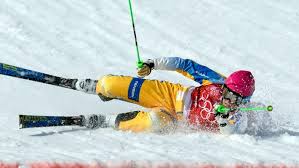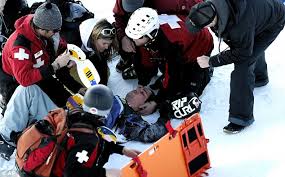
Ever since she was a teenager Canadian Sarah Jean Burke was drawn to the freestyle aspect of skiing, and early on in her career she became known as a pioneer in the superpipe event.
This form of downhill skiing is considered to be an extreme sport, with curved vertical 6.7-meter walls on either side with a pitch of between 16 to 18 degrees. The skier rockets down the center of this half tube of hard-packed snow at absolutely dizzying speeds, seemingly reckless, caution abandoned to the whipping wind.
They then use the high walls to launch themselves into the air to perform flips and tricks at various degrees of difficulty, land in the center to gather further momentum, then launch from the sidewalls again to perform even more daring aerial tricks.

It is an amazing spectacle to witness, and the athlete is marked on technical difficulty, execution, and style. The one with the highest score is declared the winner, so the skiers are always trying to outdo each other with the complexity of their flips and jumps. With a distance of 120m to cover it can be a little dangerous at times.
Her dedication saw her climb to the top of the podium at the 2001 US Freeskiing Open in the half-pipe and from there she developed a taste for winning.
The Freestyle World Ski Championships in 2005 saw the debut of the half-pipe event due to her lobbying of ESPN, and it was there that she became the first woman to successfully perform a 1080-degree rotation jump (three full-body rotations) in competition and become the first world champion.
Sarah went on to win the Winter X Games several times in the half-pipe, as well as Gold medals in slopestyle competitions, and actively promoted the superpipe event to be included in the 2010 Winter Games, where she knew she would be the favorite.

Even an accident in 2009 that broke a vertebra in her back when she landed awkwardly in a slopestyle X Games competition, didn’t slow her down for long. She continued to compete as soon as possible and advocate for the superpipe event to be introduced into the 2010 Winter Olympics. That unfortunately failed but was later successfully included in the 2014 Sochi Games, and her dream of capturing an Olympic gold was finally in sight.
It wasn’t to be.
On January 10, 2012, she suffered a crash at the bottom of a superpipe run while training in Utah. Falling was part and parcel of this daredevil sport and all of the athletes were accustomed to taking a tumble every now and then and just shaking it off.
This fall appeared to casual onlookers to be no different than many others she had endured at one time or another in her career, with the jump executed well but the landing completed awkwardly.
The true severity of the crash only became apparent moments later when she pitched backward onto the slope, in full cardiac arrest. CPR was administered immediately there and then and she was rushed to the hospital in Salt Lake City. There she was placed into an induced coma.

Neurosurgery was performed the next day to repair a vertebral artery in her neck. It had been torn during the accident, restricting the flow of blood and oxygen to her brain, which very quickly had induced the heart attack.
Due to the lack of oxygen and blood flowing to her brain, there was no chance of recovery, and she passed away on January 19.
Sarah Burke’s legacy transcended winter sports and if not for a simple accident while training she would have captured gold in the 2014 Winter Olympics. In her memory, her former coach, Trennon Paynter, scattered her ashes at the one competition she had been unable to conquer.
